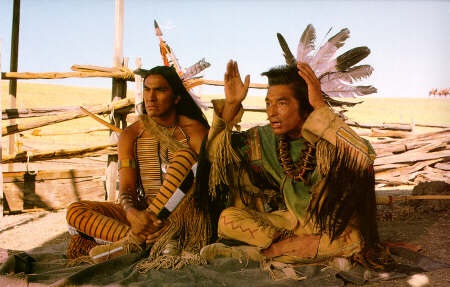Winning Academy Awards for best picture, director, cinematography, film editing, adapted screenplay, original musical score and sound mixing, Kevin Costner‘s directorial debut was a commercial and mostly critical success. (For criticism on cultural grounds, read point sixteen here). Dances with Wolves (1990) ran for approximately three-hours in theatres and nearly four-hours with the extended cut intended for home viewing.

Kevin Costner stars as the character Lieutenant John Dunbar of the American Civil War‘s Union Army whose perspective both narrates and interprets the experience of Dances with Wolves. The film, clearly a western, offers some colorful history for Dunbar that allows the film to unfurl in some form of context that offers a view into the lives of Sioux peoples. The film gets into the serious storytelling of the Sioux culture after arriving at Fort Sedgewick with Timmons, as portrayed by Robert Pastorelli.

The story of Dancing with Wolves revolves largely around getting to understand the lifestyle that was that of the Sioux peoples that lives in part of the Great Plains region of North America. The beginning of that tale in the movie involves the prejudice and stereotypes of the native and emerging United States national culture that will brings with it conflict. Dunbar keeps a diary of the initial perceptions of contact from the perspective of a Union solider. Wind In His Hair, as portrayed by Rodney A. Grant, and Kicking Bird as portrayed by Graham Greene are part of the Sioux perspective.

A significant portion of making the larger narrative of the interpersonal, non-historical story of Dances with Wolves emotionally work was a story of romance and physical communication. This placed Stands With A Fist, as portrayed by Mary McDonnell, at the center of two important pieces of that achievement. Getting to know Stands With A Fist at first took interaction with Kicking Bear and Wind In His Hair and Kicking Bird. Kicking Bird’s wife Black Shawl, as portrayed by Tantoo Cardinal, became central to building that story.

It took a fair amount of movie time for the notion of why the wolf, a character we came to know as Two Socks, developed some emotional feet. As the backstory for John Dunbar began to lose its meaning, the role of what it meant to be Union soldier gave way to what the day-to-day lifestyle of being Sioux in the community that John Dunbar had found. In a bit of a spoiler, Dunbar had been granted a Sioux name the revealed the budding relationship Dunbar had with the wolf and with the larger Sioux community. After all, Dunbar’s emotional conversion, along with the social meaning of that conversion that is a sore subject of cultural identity and portrayal for some, gets its emotional legs.

Leadership with the Sioux community that Dunbar took to heart in Dances with Wolves included Chief Ten Bears, as portrayed by Floyd ‘Red Crow’ Westerman and his wife, Pretty Shield, as portrayed by Doris Leader Charge. When the larger narrative for returning the movie to the opening backstory that started the revelation of the Sioux culture had come to pass, know that Ten Bears and his wife and Pretty Shield, along with others, played their part.

I briefly touched on the Dances with Wolves story of John Dunbar had come to Fort Sedgewick, near modern day Julesburg, Colorado in the northeast part of the state. Corporal Spivey, as portrayed by Tony Pierce, offers something meaningful for the broader brushstrokes of the movie directed by Kevin Costner that were meant to be felt. Michael Blake‘s screenplay and novel helped lead us here. I for one appreciated the story for the lifestyle of the Sioux that was shared. Acknowledging the cultural critique (read point sixteen here) that comes with the Hollywood story, our rating for Dances with Wolves is 4.0-stars on a scale of 1-to-5 stars.
Matt – Saturday, January 2, 2021
